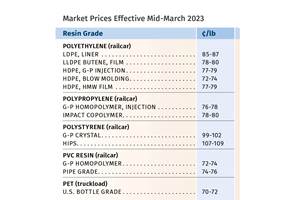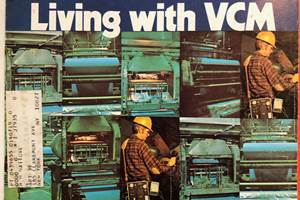EXTRUSION: Processing Rigid PVC? Know Your Rheology
Before choosing and sizing extruders for running rigid vinyl, it is wise to bone up on the viscosity behavior of the material.
In extrusion it’s generally accepted that rigid PVC (RPVC) has a high torque requirement because of its very high viscosity in the processing range. Most of the RPVC screws running today have deep metering sections and relatively shallow feed sections. This is what’s known as a low-compression screw. Deep metering sections decrease the average shear rates in that area to minimize shear heating. With a deeper screw the output is proportionally greater, and the screw does not have to turn as fast to provide the rated output. This reduces the shear heating of the polymer, which prevents overheating and degradation.
For RPVC extruders, the maximum screw speed is often set in the range of 25-35 ft/min peripheral speed, measured at the screw O.D. Consequently it’s not unusual to see a 3.5-in. single-screw extruder made for RPVC processing that’s geared to a top speed of 30-40 rpm. This gives the extruder enough torque to process the material while using the same motor size.
The shallow feed depth or low compression ratio is also appropriate to the frictional coefficients of RPVC, which cause it to feed well. Moreover, the low heat capacity and high viscosity of PVC cause melting to occur with less shear heating than many other polymers, minimizing the requirement for high compression. Remember torque, and not horsepower, is what turns the screw. With a given horsepower, torque is determined by the maximum screw speed, just like low gear in a car, as follows:
Torque in Ft-lb = (HP x 5252)/max screw speed
Most RPVC is processed not on singles, but on counter-rotating twin screws. These machines control shear heating much better than singles because they run partially filled for much of their length. That’s possible because material transport is largely achieved by mechanical means (the intermeshing flights), which significantly reduces shear-induced viscous heating. Single-screw extruders depend on viscous drag to transport the polymer and melt it.
Viscous drag is the same as viscous shear, which results in viscous heating. Because they are partially filled for much of their length, and achieve melting by as much as 70% conducted heat, counter-rotating twins do not require the same level of torque for a specific output as a single screw. Single screws are always completely full of polymer and require the high torque to transport the highly viscous polymer and melt it.
Most polymers have a shear rate-viscosity curve that is relatively flat or Newtonian in the low-shear ranges. They then take on a slope in the processing range of 10-1000 sec-1 that is relatively straight when plotted on a Log/Log graph. That slope is described by the power-law coefficient. RPVC does not have the flattened section at low shear rates, and the viscosity approaches infinity as the shear rates approach zero. Once out of the Newtonian or low-shear range, RPVC takes on a slope similar to other polymers, with the viscosity dropping rapidly with screw speed or shear rate.
The graph shows the viscosity at various shear rates for a 10 high-load melt index (HLMI) HMWPE and a RPVC. Although these polymers are relatively close to the same viscosity in the 100-1000 sec-1 range, they have very different viscosities at shear rates approaching zero, where starting torque is determined. The RPVC has a viscosity approximately eight times that of the HMWPE at zero shear, requiring very high screw torque for starting. In the typical processing range for RPVC, the viscosity drops to about twice that of HMWPE. RPVC has a very narrow processing range because of its rapid degradation if the processing temperature is exceeded.
This means that when starting a single-screw that is full of RPVC, the torque requirement can be as much as eight times the running torque. The starting torque is proportional to the zero-shear viscosity, which is a direct indication of the molecular weight of the polymer. The RPVC shown in the graph is a high-molecular-weight type, and other grades will require less starting torque.
Even though the typical extruder for RPVC has a reduced maximum screw speed to develop more torque to deal with the viscosity at the expected processing speed, it still needs a lot of extra torque to start the screw without overloading the drive. Many older extruders used DC drives, which can develop 400% of rated torque for starting. Most new extruders utilize AC drives, which cannot develop such high starting torques. So care must be taken to properly size the drive when changing from a DC- to an AC-driven extruder. You have to be able to restart the extruder in the event of an unplanned shutdown even if you normally start the screw empty and avoid the high starting torque.
There are many unique differences in PVC rheology that affect processing . When choosing and sizing extrusion machinery, best to have a thorough understanding of the material’s viscosity behavior.
Related Content
Prices of Volume Resins Generally Flat or Lower
Exceptions in early March were PP and PS, which moved up solely due to feedstock constraints, along with slight upward movement in PVC and PET.
Read MoreVCM in the News Again, Not in a Good Way
Those three letters, V-C-M, stood out from the headlines of the toxic train wreck in Ohio this past week — bringing up echoes of a time that few may remember today, when the vinyl industry was in an uproar over reports of VCM hazards in the workplace and possibly in PVC food packaging.
Read MoreJuggerbot P3-44 Astra Enables Large Format Printing With PVC
Process controls and safety systems specifically tailored for industrial printing with PVC.
Read MorePrices Flat-to-Down for All Volume Resins
This month’s resin pricing report includes PT’s quarterly check-in on select engineering resins, including nylon 6 and 66.
Read MoreRead Next
Lead the Conversation, Change the Conversation
Coverage of single-use plastics can be both misleading and demoralizing. Here are 10 tips for changing the perception of the plastics industry at your company and in your community.
Read MoreMaking the Circular Economy a Reality
Driven by brand owner demands and new worldwide legislation, the entire supply chain is working toward the shift to circularity, with some evidence the circular economy has already begun.
Read MoreFor PLASTICS' CEO Seaholm, NPE to Shine Light on Sustainability Successes
With advocacy, communication and sustainability as three main pillars, Seaholm leads a trade association to NPE that ‘is more active today than we have ever been.’
Read More
.jpg;width=70;height=70;mode=crop)





















